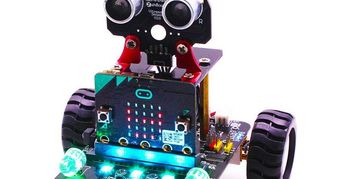🎵 Showcase your kid’s musical talent and win up to $1,000 in prize value!Enter Now
This class is no longer available, but we found something similar!
200
($100 value)

Robotics Using Microbit - Advanced Level - Hands on Projects
Ages 10-15
Live Group Class
Live video meetings
1x per week, 5 weeks
3-18 learners per class
55 min
Overview

Live Group Class
Meet over live video meetings
5 live meetings
4 hrs 35 mins in-class hoursClass Experience
If you already have the basic skills of robotics, and have been through the intermediate level robotics class, this class takes your skills even further! Each class presents a project challenge with guidance but the students are expected to write their own code from brief examples. This fosters a greater sense of accomplishment than just copying code and running it. Students then work on their project during the week with constant communication with each other and the teacher, then demonstrate their accomplishments in the next class.
The robot used in this class is the Yahboom robot with the Microbit microcontroller. This robot is the one built in the "Introduction to Robotics" class offered by me on outschool. It is recommended to take the beginner and then intermediate level classes first to prepare for this one.
The flow of each week will be:
1. New project is introduced and explained
2. Discussion about potential programming approaches, with code samples
3. Work on the project during class and during the week
4. Present the project to the class
5. Review and explore the coding methods used in the project
Weekly Schedule:
Week 1: The Bug
Each participant will program their robot to act like a "bug" and either avoid or run towards light.
Week 2: Review the bug project, results and code
Week 3: Treasure Maps
Each participant will program their robot to follow a pre-programmed treasure map utilizing the built in compass to find a treasure at the end of the map.
Week 4. Review the treasure map project, results and code
Week 5. The Maze
Discussion, tips, and sample code around teaching the robot to conquer a maze, the most traditional intelligence test.Learning Goals

This class focuses on even more advanced concepts and problem solving, while performing real world tasks.Other Details

Supply List
Each student is expected to bring to class the robot and microcontroller. This can either be built in the "introduction to robotics" class or acquired on your own from these links: http://www.perfectpackageonline.com/product/introduction-to-robotics-build-and-program-a-real-robot-with-microbit-package/4?cp=true&sa=true&sbp=false&q=false

External Resources
In addition to the Outschool classroom, this class uses:
Meet the teacher
Teacher expertise and credentials
I have been involved in computer science and robotics for 5 decades, having hand built my first robot as a teenager back in the day where parts had to be manually hard wired from scratch. In my career I have touched on many hardware / software disciplines and have several patents to my name in this field. This gives me a unique view on hardware and software as two parts of a whole end product.
In addition to the technical skills I have spent decades explaining difficult computer science concepts to non-technical crowds including investors, administrators, salesmen, etc. This provided a solid basis for teaching these skills in an age appropriate manner.
My computer science classes bring these two (technical abilities and teaching experience) together into a fun, exciting hands on experience that is age appropriate.
I have worked with this particular Yahboom robot for about 4 years now, and successfully taught basic robotics and some fairly advanced concepts) with this robot to hundreds of students. Reviews
Are you planning to use state funding, such as an Education Savings Account (ESA), Micro-grant or scholarship to help pay for your learner’s education?

